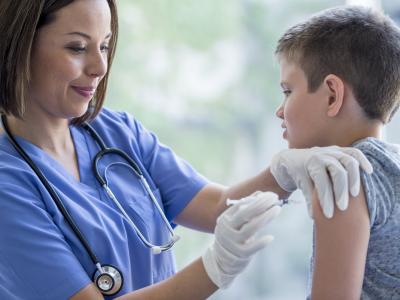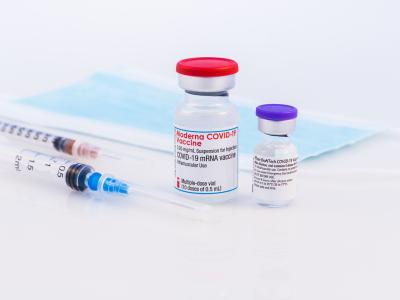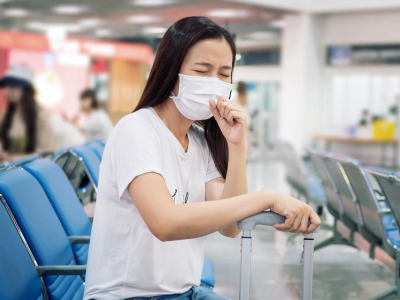Our weekly wrap-up of antimicrobial stewardship & antimicrobial resistance scans
Groups urge Congress to boost funding for AMR, antibiotic development
A coalition of more than 50 organizations is calling on Congress to boost US investments in efforts to combat antimicrobial resistance (AMR) and develop new antibiotics.
In a letter sent yesterday to members of the House of Representatives and the Senate, organizations representing public health professionals, clinicians, scientists, patients, pharmaceutical and diagnostics companies, and animal agriculture experts called for increased funding in Fiscal Year 2022 for the Centers for Disease Control and Prevention's (CDC's) efforts to address AMR, including $672 million for the Antibiotic Resistance Solutions Initiative, $100 million for the National Healthcare Safety Network, and $60 million for the Advanced Molecular Detection program.
The letters also recommend increased FY 2022 funding for AMR research at the National Institutes of Health, the Combating Antibiotic Resistant Bacteria program at the Food and Drug Administration (FDA), the Broad Spectrum Antimicrobials program at the Biomedical Advanced Research and Development Authority, and AMR research and initiatives within the US Department of Agriculture (USDA), Department of Defense, and Department of State.
"Addressing AMR is central to strengthening our preparedness for future public health emergencies, as patients with respiratory infections, serious wounds or burns, or other conditions requiring hospitalization are all at risk for secondary resistant infections," the groups wrote. "A deeper federal investment commensurate with the gravity and importance of AMR is urgently needed."
Mar 18 coalition letter
Global survey shows countries making strides in efforts to address AMR
The latest global survey conducted by the World Health Organization (WHO), the Food and Agriculture Organization of the United Nations, and the World Organization for Animal Health indicates countries are making progress on efforts to address AMR, but much work remains.
The annual Tripartite AMR country self-assessment survey, released today, shows that, compared with previous years, the number of countries that have reached nationwide implementation on several indicators has risen. Increases were observed in the number of countries with developed national action plans, countries with functional multisectoral working groups on AMR, and countries that have implemented nationwide infection prevention and control programs aligned with WHO guidelines.
A total of 136 of 194 WHO member states responded to the survey. Response rates were 11.8% lower this year because of the COVID-19 pandemic.
Analysis of data from 115 countries that have responded to the survey over the past 3 years also showed increases in the percentage of countries with nationwide AMR awareness programs and a rising number of countries that are conducting national monitoring of antibiotic consumption and surveillance activities for resistance.
Data analysis also found, however, that fewer than 50% of countries have government-funded AMR awareness campaigns, and that much of the progress is occurring in higher-income countries. While the number of countries with national monitoring systems for antibiotic consumption has increased, they account for just 54% of respondents.
"Addressing AMR solely in higher-income countries will not be enough to reduce the burden of AMR globally, especially since lower-income countries might bear the brunt of the economic and health consequences of unchecked AMR," the authors of the analysis wrote.
Mar 19 Tripartite AMR survey
Australian study shows long-term benefits of ICU stewardship intervention
Originally published by CIDRAP News Mar 18
An audit of an electronic medical record–integrated antimicrobial stewardship intervention in an Australian intensive care unit (ICU) demonstrated long-term benefits and sustainability, Australian researchers reported today in Infection Control & Hospital Epidemiology.
The intervention in the ICU at Austin Health, a tertiary referral hospital in Melbourne, Australia, was implemented in August 2017 and involved 5-day-a-week stewardship ward rounds and review of compliance with stewardship recommendations 24 hours after each ward round. The impact of the intervention over a 9-month period had previously been demonstrated.
A review of antibiotic use in the ICU 2 years before and after the intervention showed an immediate decrease in the use of ceftriaxone, meropenem, piperacillin/tazobactam, and vancomycin, and an ongoing significant reduction in the use of vancomycin and ciprofloxacin after the intervention, but no significant long-term change in the use of piperacillin/tazobactam. Prescribing appropriateness rose from 51% during the pre-intervention period (2015-2016) to 73% after the intervention was implemented (2017-2018).
During the first year after the intervention, 87.6% of stewardship recommendations were implemented by ICU staff, and 89.3% of recommendations were implemented during the second year.
The study authors say future research should focus on risk-stratifying ICU patients who would benefit most from a stewardship review.
Mar 18 Infect Control Hosp Epidemiol study
Indian scientists isolate Candida auris in the environment
Originally published by CIDRAP News Mar 17
A team of Indian scientists yesterday reported the detection of Candida auris isolates from two sampling sites on islands in the Indian Ocean—the first time the multidrug-resistant yeast has been isolated in a natural environment. The discovery was reported in mBio.
Since it was first identified in a Japanese patient in 2009, C auris has spread to hospitals around the world, and has been declared an urgent health threat by the CDC. Because the yeast is capable of growing at higher temperatures and can tolerate hypersaline environments more than other Candida species, scientists in recent years have hypothesized that it may have existed in wetlands before becoming a clinically relevant pathogen, and that its emergence could be linked to global warming's effects on wetlands.
To further explore this hypothesis, scientists from the University of Delhi collected 48 samples of sediment and seawater from coastal wetlands, sandy beaches, tidal marshes, and mangrove swamps around the Andaman Islands in the Bay of Bengal. The climate of these islands is tropical, with hot and humid conditions.
The team isolated C auris from samples at two sites, with two isolates found in a salt marsh wetland and 22 on a sandy beach. Antifungal susceptibility testing showed that one of the salt marsh isolates and all 22 from the beach—which was high in human activity—were multidrug resistant. Whole-genome sequencing revealed that the isolates were genetically distinct from C auris isolates from Indian hospitals but broadly related to clade 1, which includes isolates from South Asia.
"The isolation of C. auris from this natural environment is noteworthy considering that until now this yeast has not been identified outside hospital environmental settings," the authors wrote.
They add that the significance of the discovery, its connection to human infections, and whether the pathogen exists in other ecological niches, need to be further explored.
Mar 16 mBio study
VA study links contact precautions with reduced MRSA transmission
Originally published by CIDRAP News Mar 17
Department of Veterans Affairs (VA) hospitals that conducted contact precautions for patients with methicillin-resistant Staphylococcus aureus (MRSA) had a nearly 50% reduction in MRSA transmission, researchers reported this week in JAMA Network Open.
In the study, researchers from the VA Salt Lake City Health Care System and the University of Utah School of Medicine applied mathematical models to data from patients admitted to VA acute care hospitals from January 2008 through December 2017 to determine whether contact precautions for MRSA carriers had any impact on patient-to-patient transmission. Contact precautions, which involve the use of gloves and gowns by healthcare staff when interacting with MRSA carriers and their environment, are one element of the MRSA Prevention Initiative introduced by the VA in 2007, but their effectiveness has been questioned. Other elements include surveillance and hand hygiene.
The cohort included 108 hospitals with more than 2 million unique patients, and over the study's duration, they had more than 5.6 million admissions and 8.4 million MRSA surveillance tests (9.3% positive). Among all admissions, 14.1% required contact precautions during their stay based on a positive MRSA test result. Pooled estimates found associations between contact precautions and transmission to be stable from 2008 through 2017, with estimated transmission reductions ranging from 43% (95% credible interval [CrI], 38% to 48%) to 51% (95% CrI, 46% to 55%). Over the entire 10-year study period, contact precautions reduced transmission by 47% (95% CrI, 45% to 49%).
Larger hospitals and those with higher admission screening compliance saw additional reductions in transmission associated with contact precautions compared with smaller hospitals with lower screening compliance. VA hospitals in the southern states saw less transmission reduction linked to contact precautions compared with facilities in other regions.
The study authors say the results provide an explanation for the decline in MRSA acquisition rates in VA hospitals since the MRSA Prevention Initiative began.
Mar 15 JAMA Netw Open study
FDA approves Melinta's Kimyrsa for skin infections
Originally published by CIDRAP News Mar 16
Melinta Therapeutics of Morristown, New Jersey, announced yesterday that the FDA has approved Kimyrsa (oritavancin) for treatment of adult patients with acute bacterial skin and skin-structure infections (ABSSSIs) caused by susceptible gram-positive pathogens, including MRSA.
Kimyrsa delivers a complete course of the lipoglycopeptide antibiotic oritavancin in a single, 1-hour 1,200 milligram (mg) intravenous infusion. The drug is an updated version of Orbactiv, which was approved by the FDA in 2014 for treatment of ABSSSIs and is infused over 3 hours.
The safety and efficacy of Kimyrsa was previously established in randomized clinical trials that showed that a single 1,200 mg infusion of Orbactiv was as effective 7 to 10 days of twice daily vancomycin in treating 1,987 ABSSSI patients, including 405 with documented MRSA infection. FDA approval was based on a pharmacokinetics study that showed the safety profile was favorable to Orbactiv.
Melinta says it plans to launch the drug this summer.
"We have responded to the requests of the medical community to provide an oritavancin product with a shorter infusion time," Melinta President and CEO Christine Ann Miller said in a company press release. "We believe that with the approval of Kimyrsa and product availability this summer, physicians and patients will now have a compelling new one-dose alternative to the current standard of multi-dose regimens for ABSSSI."
Nearly 14 million US patients develop ABSSSIs each year, with more than 3 million emergency department visits. The infections cost US hospitals roughly $4 billion annually.
Mar 15 Melinta press release
Central line-associated bloodstream infections rise during pandemic
Originally published by CIDRAP News Mar 16
A new study from researchers with the CDC shows a significant increase in central line–associated bloodstream infections (CLABSIs) in US acute care hospitals during the early months of the COVID-19 pandemic.
Published yesterday in Infection Control & Hospital Epidemiology, the study analyzed 13,136 inpatient units from 2,986 acute care hospitals and found that the standardized infection ratio (SIR) for CLABSI's in April, May, and June of 2020 climbed by 28% compared with the same months in 2019, from 0.68 to 0.87. Critical care units saw the greatest percentage increase (39%) in SIR, from 0.75 in 2019 to 1.04 in 2020, and ward locations experienced the second highest increase (13%). Critical care locations had the highest number of CLABSIs in the second quarter of 2020, with 1,911.
Among ward types, significant increases in the SIR occurred in pediatric medical-surgical wards (118%), neurosurgical critical care (108%), medical critical care (60%), and medical-surgical critical care (59%). The highest regional SIR in the second quarter of 2020 (1.07) was in the Upper Northeast and represented a 45% increase compared with 2019. Hospitals of all bed sizes saw increases in SIR.
The study authors say the changes in infection control practices that were made at acute care hospitals to accommodate increasing numbers of patients during the pandemic may have contributed to the increase in CLABSIs. From 2015 through 2019, there was a 31% decline in the national SIR for CLABSIs.
"The findings of this paper highlight a substantial increase in CLABSIs in hospitals throughout the United States coinciding with the COVID-19 pandemic," they wrote. "The results of this analysis can be used to understand the increase in HAI burden being placed on the nation’s healthcare system and to prioritize ongoing efforts to prevent infections and to drive patient safety."
Mar 15 Infect Control Hosp Epidemiol abstract
US school districts adopt antibiotic use standard for turkey products
Originally published by CIDRAP News Mar 16
An organization representing the 15 largest school districts in the United States announced last week that it is issuing a standard for responsible antibiotic use in turkey products sold to schools.
Under the new policy, the Urban School Food Alliance (USFA) will require that all turkey products purchased by its schools must be produced under a USDA process verified program that includes compliance with the Certified Responsible Antibiotic Use Standard (CRAU), which was developed in 2014 to minimize antibiotic use in poultry and give schools the option to buy poultry raised with responsible antibiotic use. The turkey industry is the most intensive user of medically important antibiotics, according to research from the Natural Resources Defense Council.
Poultry producers in conformance with CRAU are prohibited from administering antibiotics pre-hatch and from using medically important antibiotics for disease prevention, growth promotion, feed efficiency, or weight gain. They can only use medically important antibiotics to treat poultry diagnosed with a bacterial disease or control disease in poultry exposed to infectious bacteria.
Turkey is the second most served protein in USFA schools, which serve nearly 4 million students daily. The group issued a similar standard for chicken in 2014.
"Issuing this standard for responsible antibiotic use in turkey is the next step in the Urban School Food Alliance’s commitment to provide the healthiest food to students in all its member districts," Katie Wilson, PhD, USFA Executive Director, said in a press release. "By leveraging the collective purchasing power of Alliance districts, this standard sends an important message to the turkey industry and helps to improve the quality of food sold to the school marketplace."
Mar 11 USFA press release










